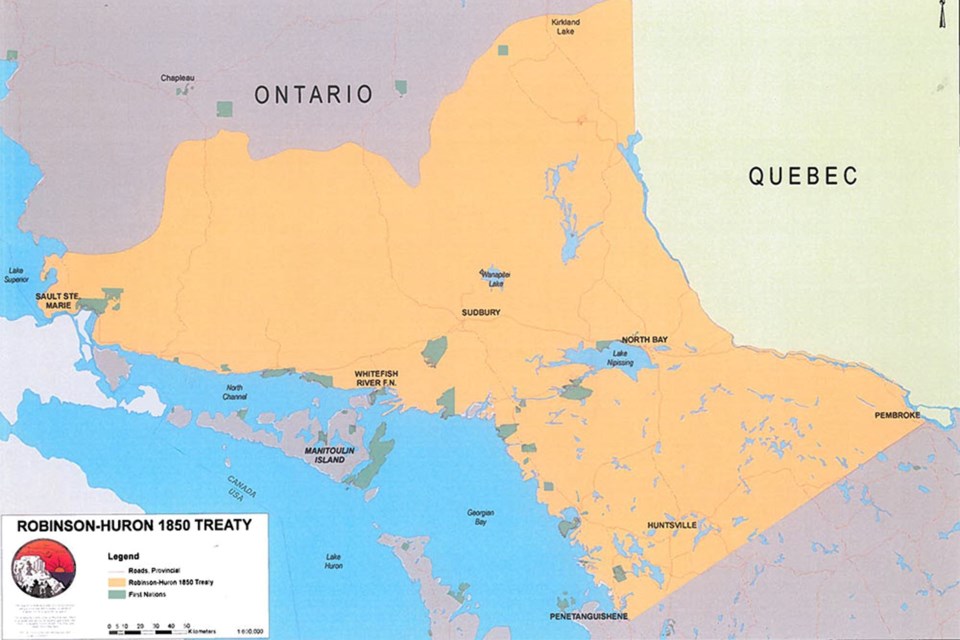The Robinson Huron Treaty Litigation fund team will be making an announcement today, June 17, at 1:30 p.m.
It’s expected that the announcement, made alongside Marc Miller, federal Minister of Crown-Indigenous relations and Greg Rickford, Ontario’s Minister of Indigenous Affairs, will offer details on the ongoing treaty annuities case.
The Robinson-Huron Treaty of 1850 Annuities Statement of Claim, which was launched by the Robinson Huron Treaty Litigation Group in 2014, involves a claim for resource revenues. At the time, the settlers of the area were driving economic growth on land that did not belong to them, encroaching on traditional lands.
Working within a framework that they understood, the sharing of resources for common good, the First Nations of much of Northeastern Ontario entered into a treaty with the Crown, as represented by William Benjamin Robinson, a former mine manager who was named treaty commissioner.
Under the treaty, the Crown promised to pay a perpetual annuity of £600 ($2,400), which in 1850 worked out to approximately $1.60 per person. But Robinson provided an additional incentive for the Anishnawbek communities to sign the treaty.
Called an ‘augmentation clause,’ it reads “[...] should the Territory hereby ceded [...] at any future period produce such an amount as will enable the Government of this Province, without incurring loss, to increase the annuity hereby secured to them, then and in that case the same shall be augmented from time to time.”
Basically, if further wealth was generated in the territory, the Crown is obligated to increase the annuity “to such further sums as Her Majesty may graciously be pleased to order.”
But the crux of the issue, and what presiding judge Justice Patricia Hennessy specifically stated in her decisions, is that the Crown failed to live up to their end of the bargain.
Not only was the annuity not raised the first year after the opening of mines everywhere in 1851, but the annuity was not increased until 1874, despite the economic growth on the land.
In 1874, the annuity amount was raised from $1.60 per person to $4 per person.
There has never been another increase. Today, that annuity is a cheque for $4 for each person.
The decisions, in what the RHTLF refers to as Stage 1 and Stage 2, both ruled in favour of the First Nations, asserting that Canada and Ontario have a mandatory obligation to review the annuity amount.
Stage 3 began in October 2022 and became a confidential negotiation process to reach a settlement between the parties. That settlement could be announced today.
In an interview with Sudbury.com in May 2021, treaty litigation fund chairperson, Mike Restoule said these potentially increased annuities would not be coming from the “taxpayer pocket,” but rather, “We're asking for a share of the revenue that the government gets from the land. It's not a share of the taxation that Ontarians pay to the government. It's a share of the revenue that the government gets from the land.”
But Restoule adds that however the revenue sharing looks, it will not only improve the lives of First Nations people and communities, but the communities surrounding them in Northern Ontario.
“If the claim is settled in favor of the Anishinabek and they gain money from this, the money will be spent in the same areas where they live,” said Restoule. “The Sagamok Anishinabek are right next door to Massey, Ontario. Guess where the money is going to end up?”
He notes not only consumer spending, but community infrastructure improvements, as well. “First Nations have homes to build. They have roads to build. Where are they going to get their supplies for that? They're probably going to get them from Massey and Sudbury.”
He sums it up fairly succinctly. “We're not going to Mexico to go and spend this money when we get it. We spend it where we live.”
Stay tuned to Sudbury.com for updates after the press conference today.
